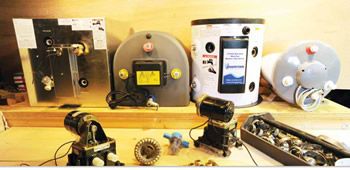Have you ever stopped and thought about how many boat heating options there are? It can be over-whelming even for the most experienced technical mechanic. And yes, there are a multitude of ways to extend the season and keep a cozy cabin, ranging from simple to complex. But how do choose the best heating option? You must consider many factors, when making this decision.
A definite correlation exists between the degree to which we are warm and dry, and the enjoyment of a sail, or a night at anchor. A damp and chilly environment may be exacerbated by a poorly insulated hull, leaks, and condensation. Sitting beneath a drippy port or headliner, or curling up in a damp bunk can make or break your sailing experience.
Your boat can be matched to a heating system that, at one end of the spectrum, will simply prevent the formation of icicles or, at the other, provide a space as warm as that den at home. Sources range from electric “cubes” and oil-filled radiators plugged in dockside, to hanging lamps, to the nautical equivalent of central heating. Cost ranges from almost nothing to the limits of your credit card.
How to determine how much heat you need? One method is to determine the average of the water and outdoor temperatures during the coldest months. Then, assume that 700 cubic feet of interior volume requires 3,000 Btu to maintain a temperature 25° higher than that average. However, there really are too many variables involved to put much stock in a formula like that. Boats, people, and locales all differ far too much, and what’s comfortable enough for one person will be misery for another.
In order to get truly adjustable comfort, or to equip a boat to stand up against temperature extremes, a fixed system will be required. We could then divide those systems into two subsets—ones that carry heat around the boat by means of pipes or ducting, and those with a strong central heat source and fans to move the air into the far reaches of the boat.
Nothing is more efficient than radiant heat produced by the sun, or a heat source that directly affects the area to which it is exposed. However, while sitting in direct sunlight on a cold or damp deck, your nose may be toasty while moss grows on your posterior.
The same is true belowdecks. Few boats are well-insulated, and whatever warmth is developed below on a cold night tends to be exchanged at a fast rate for the chilly stuff.
Here’s a scenario that will be familiar to many: The air temperature in the harbor is 40° F. and there’s a wet wind blowing at 12 knots. The water temperature is 46° F. You’re sitting in the main cabin right next to your main heat source (a wood stove, an electric radiator, whatever). Your head and torso are hot. Your hands are warm. Your feet are cold. The forepeak is cold. The aft cabin is cold. The head is cold. You lean outboard and put your feet up. Within a minute, your head is cold and your feet are hot.
You may have an excellent source of heat and a lot of Btus, but this is what life will generally be like in cold weather if you have no method to circulate warm air into occupied spaces efficiently. Options include units mounted on bulkheads that rely on fans; ducted systems with outlets in living and sleeping quarters; and heat produced by the circulation of warm fluids to a heat exchanger.
Whether you are just considering upgrading your heating system or you ready to start the project, start your research and sharpen you technical know-how by reading Nigel Calder’s comprehensive guide on how to maintain, and improve your boat’s essential systems. If it’s on a boat and it has screws, wires or moving parts, it’s covered in the Boat Owner’s Mechanical & Electrical Manual. When you dock or leave the deck with this book, you have at your fingertips the best and most comprehensive advice on technical reference and troubleshooting all aspects of your boat gear.










































